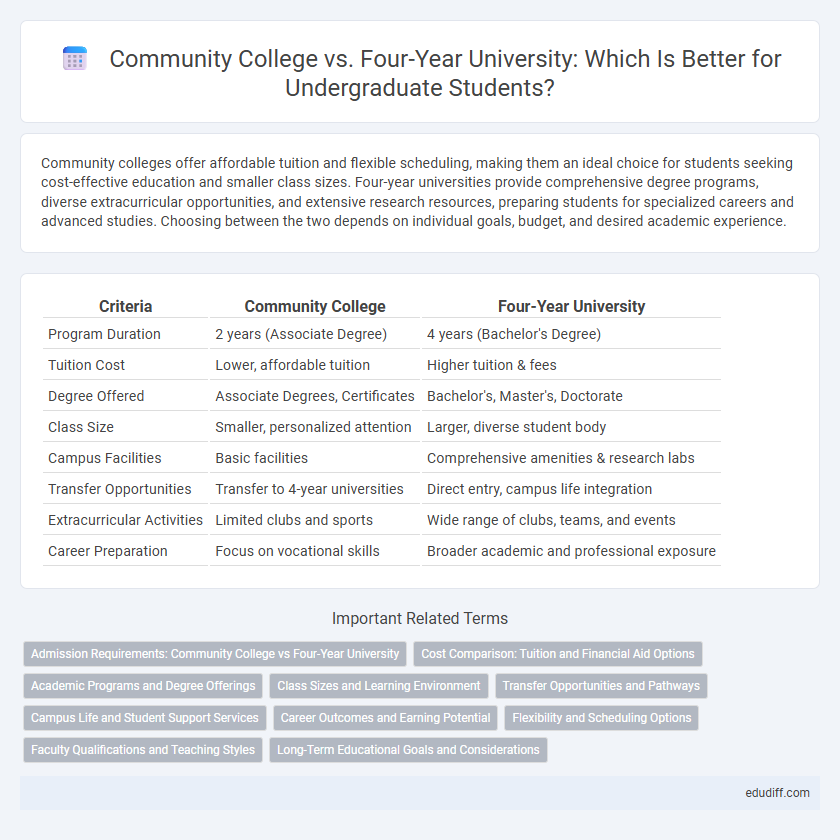Community colleges offer affordable tuition and flexible scheduling, making them an ideal choice for students seeking cost-effective education and smaller class sizes. Four-year universities provide comprehensive degree programs, diverse extracurricular opportunities, and extensive research resources, preparing students for specialized careers and advanced studies. Choosing between the two depends on individual goals, budget, and desired academic experience.
Table of Comparison
| Criteria | Community College | Four-Year University |
|---|---|---|
| Program Duration | 2 years (Associate Degree) | 4 years (Bachelor's Degree) |
| Tuition Cost | Lower, affordable tuition | Higher tuition & fees |
| Degree Offered | Associate Degrees, Certificates | Bachelor's, Master's, Doctorate |
| Class Size | Smaller, personalized attention | Larger, diverse student body |
| Campus Facilities | Basic facilities | Comprehensive amenities & research labs |
| Transfer Opportunities | Transfer to 4-year universities | Direct entry, campus life integration |
| Extracurricular Activities | Limited clubs and sports | Wide range of clubs, teams, and events |
| Career Preparation | Focus on vocational skills | Broader academic and professional exposure |
Admission Requirements: Community College vs Four-Year University
Community colleges typically have open admission policies, requiring only a high school diploma or GED, which allows more students to access higher education regardless of academic background. Four-year universities often require a competitive GPA, standardized test scores like the SAT or ACT, letters of recommendation, and personal statements for admission, making the process more selective. This distinction in admission requirements influences accessibility and student demographics at each institution type.
Cost Comparison: Tuition and Financial Aid Options
Community colleges typically offer significantly lower tuition rates compared to four-year universities, often saving students thousands of dollars per year. Financial aid options, including federal grants, scholarships, and work-study programs, are widely available at both types of institutions, but community colleges may provide more accessible opportunities for students with limited financial resources. Transferring from a community college to a four-year university after completing general education requirements can further reduce the overall cost of obtaining a bachelor's degree.
Academic Programs and Degree Offerings
Community colleges provide a diverse range of academic programs including associate degrees, certificates, and transfer pathways designed for cost-effective, flexible education. Four-year universities offer comprehensive bachelor's degrees and advanced study options with a broad spectrum of majors, emphasizing research and specialized fields. Students often choose community colleges for foundational coursework and then transfer to universities for in-depth, career-focused academic opportunities.
Class Sizes and Learning Environment
Community colleges typically offer smaller class sizes, fostering more personalized interaction between students and instructors, which enhances participation and understanding. Four-year universities often have larger classes, especially in introductory courses, which may limit one-on-one engagement but provide access to diverse academic resources and a wider peer network. The intimate learning environment at community colleges contrasts with the broader, resource-rich campuses of four-year universities, impacting student experiences and academic outcomes.
Transfer Opportunities and Pathways
Community colleges provide affordable pathways with structured transfer agreements to four-year universities, enabling students to complete foundational coursework before transferring. Articulation agreements guarantee credit recognition, facilitating seamless transitions and reducing time to bachelor's degree completion. Students often benefit from personalized advising and support services dedicated to transfer preparation, improving success rates in four-year institutions.
Campus Life and Student Support Services
Community colleges offer a more intimate campus life with smaller class sizes, fostering close student-faculty interaction and personalized support services such as tutoring centers, career counseling, and flexible scheduling. Four-year universities provide diverse extracurricular activities, extensive campus facilities, and a broader range of student support services including academic advising, mental health resources, and research opportunities. The choice between the two depends on a student's preference for community engagement and access to specialized resources.
Career Outcomes and Earning Potential
Community colleges offer affordable education with practical skills, enabling faster entry into the workforce and often leading to vocational or associate degree careers with competitive earning potential. Four-year universities provide comprehensive bachelor's degrees that open doors to higher-level professional roles and generally higher lifetime earnings across diverse industries. Career outcomes from universities typically include greater job advancement opportunities and access to specialized fields compared to community college pathways.
Flexibility and Scheduling Options
Community colleges offer flexible scheduling options including evening, weekend, and online classes, making them ideal for students balancing work or family commitments. Four-year universities often have more rigid class schedules and may require full-time enrollment, limiting flexibility for non-traditional students. This adaptability in community colleges supports diverse learning paths and accommodates various personal circumstances.
Faculty Qualifications and Teaching Styles
Community colleges often employ faculty with significant practical experience and master's degrees, fostering hands-on, personalized teaching styles that cater to diverse student needs. Four-year universities typically prioritize professors with doctoral degrees who emphasize research-driven, lecture-based instruction. This distinction affects the learning environment, with community colleges offering more direct student engagement and four-year institutions providing exposure to advanced academic theories.
Long-Term Educational Goals and Considerations
Community colleges offer affordable pathways with flexible scheduling, ideal for students seeking to complete general education credits before transferring to a four-year university or entering the workforce early. Four-year universities provide comprehensive programs and opportunities for specialization, research, and networking that are crucial for careers requiring advanced degrees or specialized training. Evaluating long-term educational goals includes considering transfer policies, accreditation, costs, and whether the institution aligns with desired career outcomes and graduate school aspirations.
Community College vs Four-Year University Infographic

 edudiff.com
edudiff.com